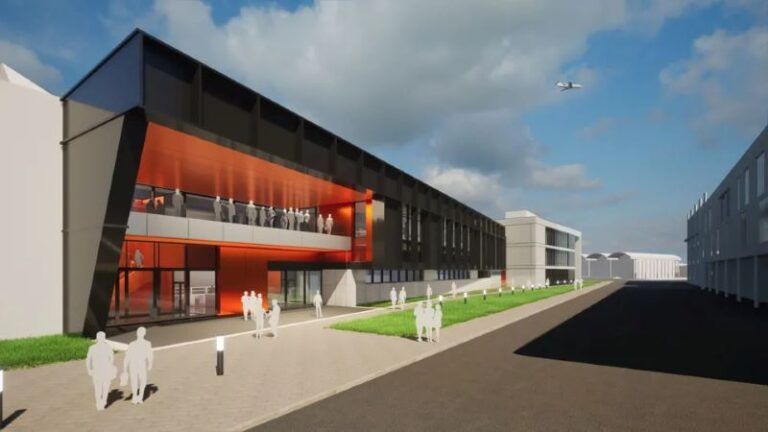The third aviation revolution – the development of a sustainable aviation infrastructure that protects both the environment and economic growth – is an essential and urgent ambition. The UK’s net-zero aviation emissions by 2050 target is beginning to feel imminent.
Once the outsider in the race to deliver zero-carbon flight, hydrogen has become the frontrunner as the middle to long-term solution.
Just as automotive manufacturers have become market leaders from investing early in electric vehicles, aviation businesses can now establish a lead in hydrogen. The kind of lead and experience that will be difficult for competitors to catch up with.
This work is happening at the Cranfield Hydrogen Integration Incubator (CH2i), which was launched in April. CH2i is based in and around Cranfield University’s own airport facilities, its workshops and a planned new set of hydrogen-focused lab spaces.
Partnerships are beginning to define programs of work as a means of unlocking the technology challenges, including hydrogen production technologies, catalysts, materials, structures, storage tanks and both engine and whole aircraft designs. An incubator geared towards rapid innovation in a regulated and safety-focused environment.
A partnership approach to developing hydrogen aviation
No doubt, creating a viable hydrogen ecosystem comes with huge challenges. But the large-scale lab spaces needed for working out the processes, from green production to transportation, storage and use both airside and in aircraft, are in place.
Industry players such as Airbus, Heathrow Airport, Marshall, Siemens Energy and Toyota have become involved. All that is needed now is more collaboration between research institutions and aviation businesses, manufacturers, airports, airlines and their suppliers to innovate, test and demonstrate the most workable technologies and processes.
This type of joint activity will lead to a robust offering and the development of certification processes and rules that ensure the introduction of hydrogen meets or even improves current safety standards.
CH2i is being developed with £23 million (US$30 million) from Research England’s Research Partnership Investment Fund (UKRPIF) and £46 million (US$60 million) from industry partners and academic institutions. The Hydrogen Integration Research Centre will include new laboratories for advanced materials synthesis and testing and a dedicated innovation area to develop a hydrogen pilot plant demonstration, electrolysis, catalyst development and green hydrogen.
Alongside this, an Enabling Hydrogen Innovation test area will be focused on gaseous and liquid hydrogen fuel systems, working on both storage and propulsion system integration at mid- and high-technology readiness levels.
Handling hydrogen research
The facilities and ambition of CH2i are rooted in Cranfield’s experience in hydrogen application research since the early 1990s. A new generation plant has been used for testing bulk production of ‘blue’ hydrogen on the University campus.
Working with the US-based Gas Technology Institute (GTI) and British energy company Doosan Babcock, the 1.5 megawatt-hour pilot plant demonstrated how high-purity hydrogen can be produced at up to 30% lower cost than conventional steam methane reforming methods (that depend on CO2 capture as an additional and expensive step in the process). Carbon emissions are cut by 97% compared with traditional hydrogen production.
Research has also tested the feasibility of using biogas feedstocks (supplied from anaerobic digestion plants processing food, plant and animal waste around the UK) for hydrogen production.
The University has been building up direct experience in production and refueling via its solar-powered electrolyzer, producing up to 40kg of green hydrogen per day. An electric-hydrogen refueling truck supplies research projects working on hydrogen fuel-cell aircraft.
There is also ongoing research into the most workable materials for liquid hydrogen fuel tanks as part of the £40 million (US$52 million) Airbus project to develop the world’s first commercial hydrogen aircraft by 2035. This involves designs for a type VI cryogenic tank founded on a guarantee that even if active cooling or other systems fail, the materials being used will keep the liquid hydrogen at a safe temperature and pressure environment for long enough for the aircraft to land and issues resolved.
New materials involved in the cryogenic tank research include a self-healing polymer, aerogels (synthetic porous ultralight materials) and a graphene layer. The first prototype of type VI cryogenic hydrogen tank is being tested this year, with flight testing expected to start in 2026.
Other research is exploring the use of ammonia for carbon-capture hydrogen storage and waste-to-fuel processes and the practicalities of implementing hydrogen refueling across airports using compressed gas and/or liquid hydrogen alongside Heathrow Airport.
Cranfield is trialing airside hydrogen vehicles: a hydrogen fuel cell baggage tractor at Bristol Airport alongside easyJet; a hydrogen-powered aircraft tow-tug at Cranfield’s airport; and, at Exeter Airport, a system of multiple hydrogen vehicles, the tractor and tow-tug, as well as a ground power unit which uses a hybrid of diesel and hydrogen fuels that demonstrates the cheapest and most pragmatic way of implementing hydrogen for airport ground equipment.
The CH2i hub will be a way to make things happen and make vital progress in proving the viability of a high-potential technology. That means a lead for businesses willing to be early investors and adopters — as well as for the aviation industry as a whole.
More information on involvement with the Cranfield Hydrogen Integration Incubator (CH2i) is at www.cranfield.ac.uk/h2 or by contacting h2@cranfield.ac.uk





